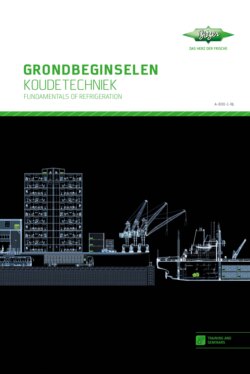Читать книгу GRONDBEGINSELEN KOUDETECHNIEK / In twee talen Nederlands/Engels - Volker Stamer - Страница 20
На сайте Литреса книга снята с продажи.
Оглавление(voor water bij 100 °C) en de hiervoor benodigde
energie verdampingswarmte r. Deze verandering van
aggregatietoestand verhoogt ook de enthalpie van de
stof, maar de temperatuur blijft tijdens het verdamping-
sproces constant.
De moleculen van een vloeistof moeten de onderlinge
aantrekkingskrachten overwinnen om te kunnen
verdampen.
Door de grotere bindingskrachten die in een vloeistof
optreden, is de verdampingswarmte veel hoger dan de
smeltwarmte. Het veranderingsproces van de aggre-
gatietoestand is voor alle stoffen (niet alleen water)
hetzelfde, terwijl de smelt- en kooktemperatuur stof-
afhankelijk zijn. Zie de tabel voor voorbeelden van
enkele stoffen.
Elke stof kent drie verschijningsvormen (vast, vloeibaar
en gasvormig). Oververhitte damp wordt „gas“ genoemd
(bijv. lucht is onder bepaalde omgevingsomstandig-
heden in oververhitte toestand). Wanneer we van
„gas“ in plaats van „damp“ spreken, is in nog geen
enkele technische basisregel vastgelegd.
evaporation r. The enthalpy of the substance also
increases for this change in physical state, but the
temperature remains constant during the evaporation
process.
The molecules of a liquid must overcome the mutual
forces of attraction for it to evaporate. Because of the
greater binding forces that occur in a liquid, the heat
of evaporation is much greater than the heat of fusion.
The sequence of changes in physical state is the same
for all substances (not only water), where the melting
and boiling temperatures are substance-dependent.
Examples of some substances are given in Tab. 1.
Each substance can occur in three forms (solid, liquid
and gaseous). Highly superheated vapour is referred to
as a ‘gas’ (e.g. air at ambient conditions is in a highly
superheated state). From which superheating state
we refer to ‘gas’ instead of ‘vapour’ has not yet been
defined in any technical basic rules.
Tab. 1
Smelt- en kooktemperatuur van enkele stoffen bij p = 1,013 bar
Melting and boiling temperatures of selected substances at p = 1.013 bar
Stof
Substance
Smelttemperatuur
Melting point
in °C
Smeltwarmte q
Heat of fusion q
in kJ/kg
Kooktemperatuur
Boiling point
in °C
Verdampingswarmte r
Heat of evaporation r
in kJ/kg
Water (R718)
Water (R718)
0.0
333.8
100.0
2 256.5
Ammoniak (R717)
Ammonia (R717)
–77.7
339.0
–33.3
1 369.5
Koudemiddel R600a
Refrigerant R600a
–159.4
78.2
–11.8
365.1
Koudemiddel R134a
Refrigerant R134a
–103.7
205.1
–26.1
217.0
Zuurstof
Oxygen
–222.7
13.9
–183.0
213.2
Stikstof
Nitrogen
–209.9
25.7
–195.8
199.4
Aluminium
Aluminium
660.3
396.6
2 518.9
10 778.0
Koper
Copper
1 084.7
206.8
2 561.9
4 729.0
IJzer
Iron
1 534.9
247.1
2 860.9
6 258.0
Faseveranderingen (verdampen, condenseren) van
een stof zijn zeer belangrijk op het gebied van koude-
techniek. We zullen hier aan de hand van Fig. 12
dieper op ingaan. Hiervoor gebruiken we water als
voorbeeld, maar het patroon is voor alle stoffen
hetzelfde.
Because the change in phase (evaporating, condens-
ing) of a substance is very important in the refrigeration
field, they will be considered more closely using Fig. 12.
Water is used as an example, but the pattern is the
same for all substances.
22
Grondbeginselen thermodynamica // Fundamentals of thermodynamics
